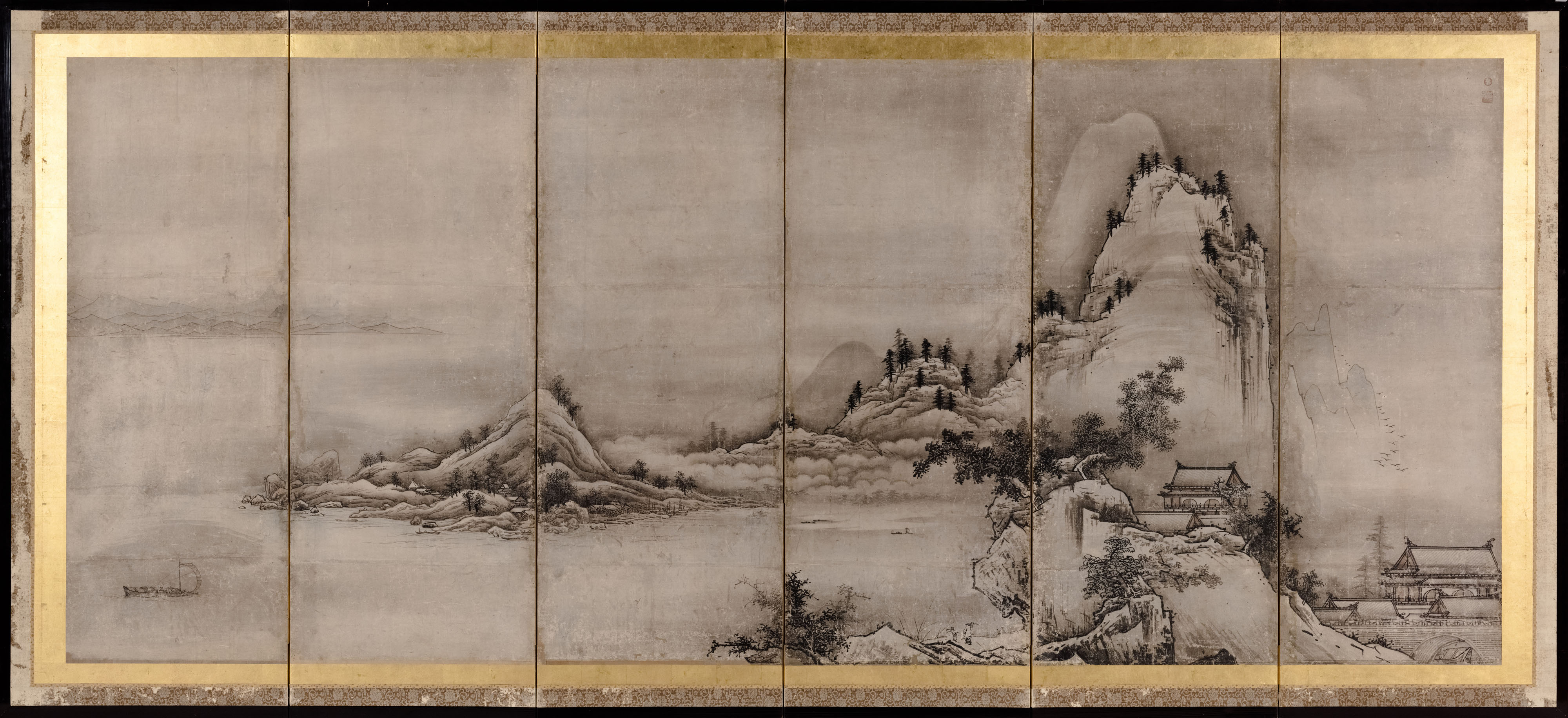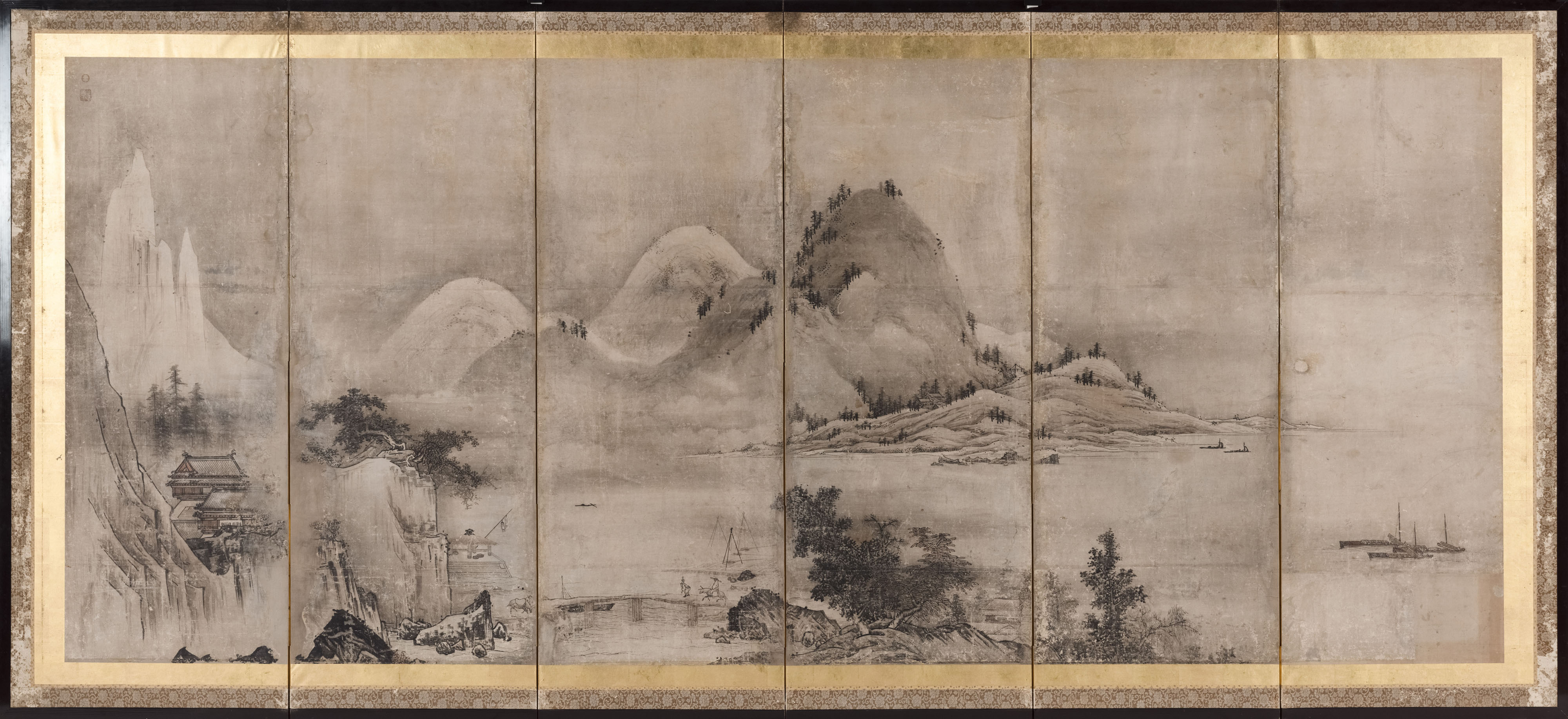
さんすいず 山水図
不詳(安土桃山時代)
紙本墨画淡彩
雲谷派の祖・等顔による代表作のひとつ。国内に残る山水図屛風では制作時期が最も早い例として知られます。両隻とも画面手前には樹木が生えた岩山と楼閣、そこへ向かう笠をかぶる人物とお供の童子を描いています。中ほどにはどっしりとした山、周囲には雲海がたなびき、湖には舟も行き来しています。遠くには山が奥へと連なる様子を墨と藍色でうっすらと描き、空間の広がりを表しています。
等顔は岩、楼閣、舟といった山水図を構成するモチーフを、雪舟《山水長巻》(国宝・毛利博物館蔵)から学びました。等顔は雪舟にならい、岩や樹木を濃い墨の線で力強く表す一方、光や霧などの自然現象を淡い墨で細やかに表しています。とくに左隻中央の山並みは、夕暮れ時、にわか雨が降った後のような、しっとりとした山肌の美しさが印象的です。またその右奥には月が浮かんでおり、空間だけではなく時間の経過をも感じさせ、観る者の想像力をかき立てる作品です。
雲谷等顔【うんこく とうがん】
生没年 1547-1618(天文16年~元和4年)
肥前国能古見(のごみ)(佐賀県鹿島市)の城主原直家の次男で、狩野永徳あるいは松栄に師事したと伝わります。毛利輝元から雪舟《山水長巻》(国宝・毛利博物館蔵)と雪舟の画室雲谷庵を授かり、雪舟流を継ぐ雲谷派を創設。萩を拠点に京都・大徳寺や東福寺の襖絵制作も行い、法眼(ほうげん)に叙任。連歌、茶の湯を嗜み、輝元に御伽衆(おとぎしゅう)として重用されました。
| 寸法 | 147.0×346.4cm |
|---|---|
| 形状 | 六曲屏風 |

Landscape
Ink and light color on paper
This is one of the most important works of Unkoku Togan, the founder of the Unkoku School. It is known that this work is among the earliest of the landscape paintings on folding screens extant in Japan. Taken together, the two screens depict rocky mountains with trees growing on them, a building, with a person wearing a wide-brimmed straw hat and an attendant child in the foreground. These people are walking toward a building. A solid mountain is standing in the middle, with a sea of clouds drifting around it, and some boats are afloat on a lake. A distant range of mountains, extending into the scene’s far prospect, is depicted faintly, using ink and indigo blue. This technique finely expresses the great expanse of the space depicted.
Togan learned about the use of such motifs as rocks, buildings and boats, important components of landscape painting, from Sesshu, the painter of the “Long Landscape Scroll” (a National Treasure in the possession of the Mohri Museum). Imitating Sesshu’s style, Togan painted rocks and trees with strong strokes of dark ink. On the other hand, he depicted natural phenomena like the play of light and fog with fine touches of faint ink. The mountain range in the center of the left screen particularly impresses the viewer with the beauty of the calm mountain surfaces. It looks like they have just been caught in a sudden shower at twilight. Then, there is the moon floating in the sky behind the scene, to the right of the picture. This calls to the viewer’s mind the elapse of time as well as the expanse of space. This work definitely stimulates the viewer’s imagination.
Unkoku Togan (1547 – 1618)
Togan was the second son of Hara Naoie, lord of Nogomi Castle in Hizen Province (the present-day Kashima City, Saga Prefecture). He is believed to have studied under Kano Eitoku or Kano Shoei. The feudal lord Mohri Terumoto gave him the “Long Landscape Scroll” (now in the possession of the Mohri Museum), a famous painting created by Sesshu. He was also provided with his studio, “Unkoku-an”, and there he founded the Unkoku School, which adopted Sesshu’s painting style. Although based in Hagi (the present-day Hagi City, Yamaguchi Prefecture), he worked energetically in various other parts of the country, including Kyoto. It was there that he produced fusuma-e (paintings on sliding doors) for both the Daitoku-ji Temple and the Tofuku-ji Temple. He became hogen (the second highest rank in the hierarchy of Buddhist monks). He liked writing renga (linked verses collaboratively written by more than one poet) and the tea ceremony, and served Mohri Terumoto as an otogishu (storyteller).
| Size | 147.0×346.4cm |
|---|

山水圖
雲穀派鼻祖等顏的代表作之一,也是日本國內留存的製作時期最早的山水圖屏風典例。兩幅都在畫麵前都描繪了樹木生長的山岩與樓閣,以及前往那裏的戴鬥笠的人與相伴的仕童。畫麵中部是敦實的山,周圍雲海繚繞,湖麵上有來往的船隻。遠處用墨及藍色隱約勾畫出群山向深處延伸的樣子,變現了空間上的擴展。
等顏從雪舟的《山水長卷》(國寶·毛利博物館藏)中,學習了岩石、樓閣、船隻等山水圖的主題構成。等顏效仿雪舟,一方麵用濃墨線條有力地表現出岩石與樹木,另一方麵用淡墨細膩地表現出光與霧等自然現象。特別是左邊屏風中央的山,就像黃昏時分陣雨過後一般,山肌的濕潤感給人以深刻的印象。此外,月亮懸浮在右側深處,不僅在空間上,還能感受到時間上的流逝,是一幅能揮發觀者想象力的作品。
雲穀 等顏
生卒年 1547~1618(天文16年~元和4年)
據說是肥前國能古見(佐賀縣鹿島市)城主原直家的次子,拜師狩野永德與鬆榮。從毛利輝元傳承了雪舟的《山水長卷》(國寶,毛利博物館藏)以及雪舟的畫室雲穀庵,繼雪舟流派後創立了雲穀派。以萩市為據點,繪製了京都大德寺和東福寺的隔扇畫,繼任法眼(僧位)。他愛好連歌、品茗,被輝元重用為禦伽眾(大名家的職掌)。
| 尺寸 | 147.0×346.4cm |
|---|

산수도
본 작품은 운코쿠파의 시조 도간의 대표작 중 하나입니다. 일본 국내에 남아 있는 산수도 병풍 중에서는 제작 시기가 가장 이른 작품으로 알려져 있습니다. 두 점 모두 그림 앞쪽에는, 나무들이 자라고 있는 바위산과 누각, 그리고 그 곳을 향하고 있는 삿갓을 쓴 인물과 그 길을 함께하는 동자를 그렸습니다. 중앙에는 듬직한 산, 주변에는 운해가 길게 깔려있으며 호수에는 배도 오가고 있습니다. 멀리 보이는 산이 깊숙이까지 이어지는 풍경을 먹과 감색으로 옅게 그려내어 공간의 확장을 표현했습니다.
도간은 바위, 누각, 배 등 산수도를 구성하는 모티브를 셋슈의 《산수장권》(국보・모리박물관 소장)을 보고 배웠습니다. 도간은 셋슈를 본받아, 바위나 나무를 짙은 먹을 이용해 힘 좋게 선으로 표현하는 한편, 빛이나 안개 등의 자연현상을 묽은 먹으로 섬세하게 표현하였습니다. 특히 왼쪽 작품 중앙에 그려져 있는 산들을 보면, 마치 해질녘 소나기가 한창 퍼붓고 난 후의 모습처럼 촉촉한 산의 표면에서 아름다움이 느껴지는 점이 인상적입니다. 또한 오른편 안쪽에는 달이 떠있는데, 공간뿐만 아니라 시간의 경과도 느낄 수 있어, 보는 사람의 상상력을 불러일으키는 작품입니다.
운코쿠 도간
생몰년 1547년 ~1618년 (덴분16년~겐나4년)
히젠국 노고미(현재의 사가현 가고시마시)의 성주 하라나오가의 차남으로 가노 에이토쿠 또는 쇼에이에게 사사하여 가르침을 받았다고 알려져 있습니다. 모리 테루모토로부터 셋슈의 《산수장권》(국보 모리 박물관 소장)과 셋슈의 화실 운코쿠안을 받아 셋슈류를 계승하는 운코쿠파를 창설했습니다. 하기를 거점으로 교토 다이토쿠지 절이나 도후쿠지 절의 장벽화(후스마에)를 제작하였고, 승려 계급 중 하나인 ‘법안(法眼)’으로 서임. 일본의 전통 시 형식인 렌가(連歌)와 다도를 즐겼으며, 테루모토에게 주군이나 다이묘의 말상대를 하는 관직인 ‘오토기슈’로 중용되었습니다.
| 치수 | 147.0×346.4cm |
|---|


